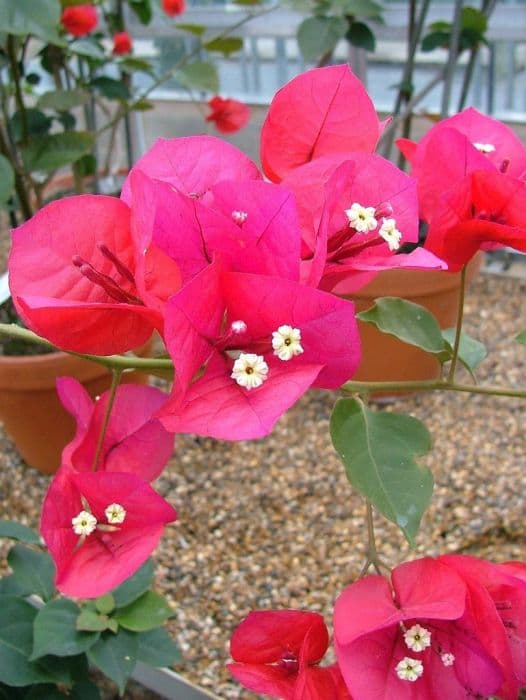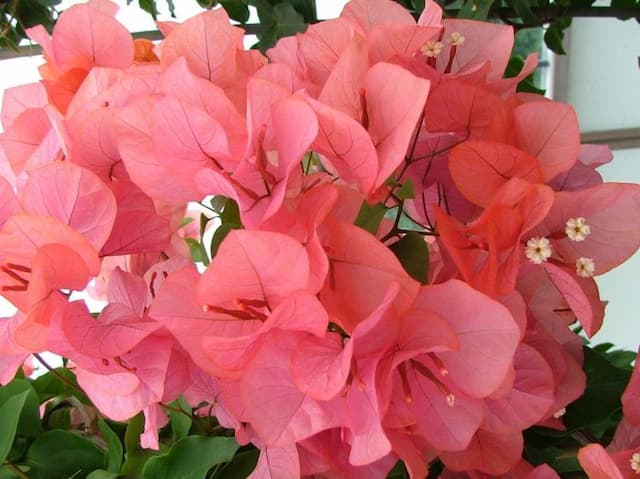Four O'clock Flower Mirabilis jalapa

ABOUT
The plant commonly known as the four o'clock flower is notable for its striking trumpet-shaped blooms which come in a vibrant array of colors. The flowers may be in hues of pink, red, yellow, white or even multicolored patterns that can include stripes or sectors of different colors on the same petal. The foliage consists of lush green leaves, which are oval to heart-shaped, with smooth edges that provide a rich backdrop to the colorful flowers. The four o'clock flower opens its blossoms in the late afternoon, hence its common name, and they often stay open until the following morning. Their fragrance intensifies during the night, which attracts nocturnal pollinators such as moths. The plant has a bushy habit, producing a profusion of flowers when in bloom. It grows from tuberous roots which allow it to survive periods of dormancy and re-emerge with vigor in the growing season.
About this plant
 Names
NamesSynonyms
Four O'Clock, Marvel of Peru, Beauty of the Night, Wishbone Bush, Heartleaf Umbrellawort.
Common names
Mirabilis dichotoma, Mirabilis lindheimeri, Nyctago jalapa, Nyctago versicolor, Jalapa officinalis, Mirabilis congesta, Mirabilis cordifolia, Mirabilis hispida, Mirabilis longiflora, Mirabilis peruviana, Quamoclit angulata.
 Toxicity
ToxicityTo humans
The four o'clock flower is considered to have low toxicity for humans. However, ingesting any part of the plant, especially in significant amounts, can potentially cause symptoms such as nausea, vomiting, or diarrhea. The seeds are thought to contain the highest concentration of the plant's toxic elements. In most cases, symptoms are mild and self-limiting, but it's advisable to seek medical attention if substantial quantities are consumed, especially by children, or if severe symptoms develop.
To pets
The four o'clock flower is also toxic to pets, including dogs and cats. Ingesting any part of the plant can lead to gastrointestinal upset in pets, which may manifest as vomiting, diarrhea, or lethargy. As with humans, the seeds are particularly toxic, so they should be kept out of reach. If a pet ingests a large amount of this plant, or if any concerning symptoms arise, it is important to contact a veterinarian as soon as possible.
 Characteristics
CharacteristicsLife cycle
Perennials
Foliage type
Deciduous
Color of leaves
Green
Flower color
Varies
Height
2-3 feet (0.6-0.9 meters)
Spread
1-2 feet (0.3-0.6 meters)
Plant type
Herb
Hardiness zones
9
Native area
Tropical America
Benefits
 General Benefits
General Benefits- Ornamental Value: Mirabilis jalapa, commonly known as Four O'Clock Flower, has vibrant, trumpet-shaped flowers that add aesthetic beauty to gardens.
- Night Blooming: The flowers open in the late afternoon, hence the name Four O'Clock Flower, providing unique interest in the evening garden.
- Fragrance: The blooms often have a sweet fragrance that intensifies in the evening, attracting pollinators and adding sensorial appeal to the environment.
- Ease of Growing: The plant is known for being easy to grow and maintain, making it suitable for gardeners of all skill levels.
- Drought Resistance: Once established, Mirabilis jalapa is quite drought-tolerant, requiring minimal watering in suitable climates.
- Self-Seeding: The plant is a prolific self-seeder, which means it can reliably provide new growth year after year without needing to be replanted.
- Recreational Gardening: Due to its low maintenance and attractive qualities, it encourages recreational gardening activities among enthusiasts.
- Versatility: Four O'Clock Flowers can be grown in pots or in the ground, offering flexibility in garden design and space utilization.
- Fast-Growing: It grows relatively quickly, offering rapid gratification for gardeners looking to see results from their planting efforts.
 Medical Properties
Medical Properties- Anti-inflammatory: Mirabilis jalapa has been used traditionally to reduce inflammation.
- Diuretic: The plant is believed to promote the excretion of urine.
- Antiseptic: It has properties that help in preventing the growth of disease-causing microorganisms.
- Laxative: The plant has been used to relieve constipation.
- Expectorant: Mirabilis jalapa has been used to aid in the expulsion of phlegm from the airways.
- Wound healing: It is applied traditionally to wounds to promote the healing process.
- Antimicrobial: The plant possesses substances that are effective against certain types of bacteria and fungi.
 Air-purifying Qualities
Air-purifying QualitiesThis plant is not specifically known for air purifying qualities.
 Other Uses
Other Uses- Mirabilis jalapa, commonly known as four o'clock flower, can be used as a colorful natural dye for textiles and papers, resulting from its pigmented flowers.
- The juice from the flowers of the four o'clock plant can be used as an ink for writing or as a natural colorant for artworks, giving a range of pink and magenta tones.
- Four o'clock flower seeds have been used in traditional games by children in various cultures, similar to marbles, due to their hard and rounded shape.
- The roots of Mirabilis jalapa are known to be rich in saponins and can be used as a natural soap or cleaning agent when crushed and mixed with water.
- The fragrant flowers of the four o'clock plant are sometimes incorporated into potpourris or used to infuse a sweet fragrance into household items like linens and stationary.
- The crushed leaves of the Mirabilis jalapa have been used as an animal feed supplement, particularly in the poultry industry, though this is not widespread due to potential toxicity.
- By planting Mirabilis jalapa strategically in the garden, one can use the plant to create a living fence or border that blooms in the evening, adding beauty and privacy.
- Four o'clock flowers are sometimes used in culinary presentations as an edible decoration, although they should not be eaten in large quantities.
- The vibrant tubular flowers of the Mirabilis jalapa can serve as temporary water containers for small insects and birds when upturned after rainfall.
- The sticky sap of Mirabilis jalapa's stems has been used in some cultures for minor adhesive tasks, such as sealing small envelopes or paper folds.
Interesting Facts
 Feng Shui
Feng ShuiThe Four O'Clock Flower is not used in Feng Shui practice.
 Zodiac Sign Compitability
Zodiac Sign CompitabilityThe Four O'Clock Flower is not used in astrology practice.
 Plant Symbolism
Plant Symbolism- Perseverance and Resilience: Known for its ability to thrive in harsh conditions, Mirabilis jalapa, commonly known as the Four O'Clock Flower, represents perseverance and the ability to overcome challenges.
- Inconstancy: The Four O'Clock Flower blooms in the evening and closes in the morning. This fluctuation mirrors human inconstancy, reflecting changing emotions or unreliability.
- Mystery and Secrets: The plant's unique blooming time when night falls is associated with mystery and the keeping of secrets.
- Beauty and Celebration: With brightly colored flowers, the Four O'Clock represents the beauty in life and often features in festive occasions, symbolizing joy and beauty that should be celebrated.
- Time and Reflection: The predictable blooming of the flowers in late afternoon is a reminder of time's passage and encourages reflection on the day's events or life's transient nature.
 Water
WaterThe Four O'Clock flower, commonly known as Mirabilis jalapa, prefers regular watering to keep the soil consistently moist, but not waterlogged. During active growth in the spring and summer, water the plant deeply once a week with about one gallon of water per square foot, adjusting for rainfall. Reduce watering frequency to every two weeks in the fall and to minimal watering in the winter, as the plant goes dormant. Always check the top inch of soil for dryness before watering to prevent overwatering. Overwatering can lead to root rot, so it's crucial to ensure good drainage.
 Light
LightThe Four O'Clock flower thrives in full sun to partial shade. For optimal flowering, place it in a spot where it can receive at least six to eight hours of direct sunlight daily. While it can tolerate some shade, too little light can reduce blooming and cause the plant to become leggy.
 Temperature
TemperatureFour O'Clock flowers are tolerant of a wide temperature range but perform best when the temperature is between 60 and 85 degrees Fahrenheit. They can survive minimal frosts, but prolonged exposure to temperatures below 50 degrees Fahrenheit can damage or kill the plant. Protect the plant from extreme cold and consider mulching to keep the roots warm during cooler months.
 Pruning
PruningPruning Four O'Clock flowers is done primarily to remove spent blooms and to shape the plant. Deadhead regularly to encourage more blooms and to keep the plant tidy. In the spring, prune any dead or damaged stems to promote new growth. Pruning is usually not needed during the growing season, but standard maintenance to remove old flowers can be performed as needed.
 Cleaning
CleaningAs needed
 Soil
SoilFour O'Clocks thrive in well-draining, fertile soil with a neutral to slightly acidic pH of 6.0 to 7.5. A mixture of two parts garden soil, one part compost, and one part sand or perlite makes the best soil blend for these plants. Regular feeding with a balanced fertilizer during the growing season will promote lush foliage and vibrant blooms.
 Repotting
RepottingFour O'Clocks are typically grown as annuals, so repotting isn't often necessary. However, if grown as perennials in pots, they should be repotted every 2-3 years in spring to provide fresh soil and more space for root growth.
 Humidity & Misting
Humidity & MistingFour O'Clocks are not particularly demanding regarding humidity and can adapt to average outdoor conditions. They can tolerate some dryness, but prefer moderate ambient humidity levels to thrive.
 Suitable locations
Suitable locationsIndoor
Place Four O'Clocks in bright, indirect light and avoid overwatering.
Outdoor
Plant Four O'Clocks in full sun to partial shade and water regularly.
Hardiness zone
7-10 USDA
 Life cycle
Life cycleMirabilis jalapa, commonly known as the four o'clock flower, begins its life cycle as a seed which, when sown, germinates in warm soil typically in spring or early summer. Following germination, the seed develops into a seedling, which further matures into a bushy, herbaceous perennial plant. The plant then enters a vegetative state where it develops a thick, tuberous root system and robust stems with ovate, pointed leaves. During the flowering stage, which usually occurs from late afternoon to morning – hence the common name – the plant produces trumpet-shaped, fragrant flowers that can be white, red, yellow, pink, or bicolor. After pollination, typically by moths or other nocturnal insects, the flowers produce small, black, spherical seeds that are encased in a dry, papery fruit. At the end of the growing season, if conditions are not suitable for overwintering, the plant dies back to the tuberous root, allowing it to survive until the next favorable season for growth.
 Propogation
PropogationPropogation time
Spring to Summer
Propogation: The Four O'Clock Flower, known scientifically as Mirabilis jalapa, is typically propagated from its tuberous roots and by seeds. The most popular method of propagation for this plant is by seed. Seeds can be directly sown into the garden where the plant is to grow in late spring after all danger of frost has passed. They should be planted about 1/4 inch deep in the soil and spaced about 2 feet apart to allow for eventual growth. The seeds will typically germinate in 3 to 14 days. It is helpful to soak the seeds in water for a few hours before planting to encourage germination. Once the seedlings are established, they require minimal care and will start blossoming in the early evening around the same time the following year.






![Bougainvillea [Texas Dawn]](/_next/image?url=https%3A%2F%2Fplants-admin.emdemapps.com%2Fimages%2Fplants%2F%2Fimages%2F604b5f2598081.png&w=640&q=75)


